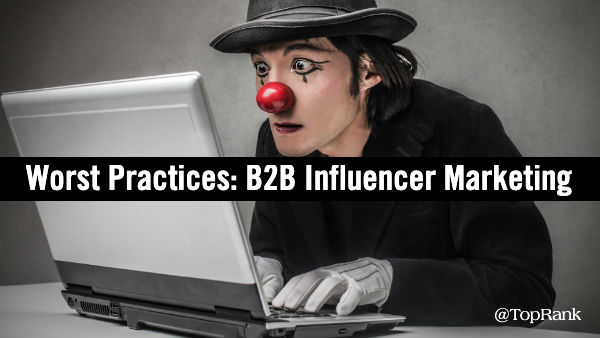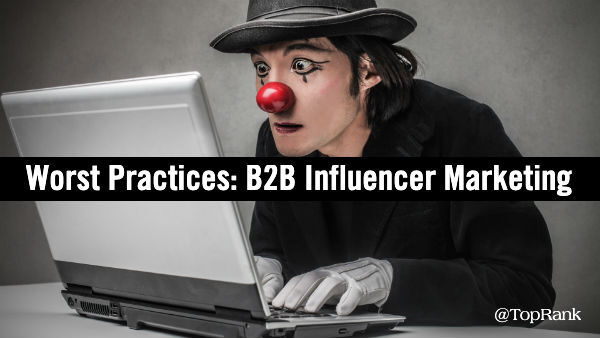
When it comes to sharing B2B marketing advice, I prefer not to clown around too much and do my best to be positive and optimistic with trends, insights and how to’s focused on looking forward towards best practices and getting better results.
Marketers expect serious results but unfortunatley, many B2B marketers insist on clowning around with half-hearted or incomplete influencer marketing efforts.
I know this from stories told by brand marketers that have worked with other agencies and from being on the receiving end of clueless pitches, minimum viable engagement efforts and willfully ignorant attempts to get me to promote something I really have no business caring about. I’ve heard much of the same from other people who are often engaged as influencers as well.
This post is an appeal to B2B marketers to stop clowning around with influencer marketing efforts, especially now when marketing has no room to be wasteful or unsuccessful. Below is a list of some of the worst offenders. If your B2B company is doing these things, whatever efficiency or shortcut you’re hoping for is a joke on you in terms of program success and building real relationships with the credible experts your customers listen to.
1. Lead Gen Disguised as Brand Awareness – Marketers initiating an influencer program with stated goals of increasing brand awareness inevitably always shift their thinking midway through and start talking about lead generation and sales expectations if not from the start. Of course building brand awareness and lead generation are two different strategies with different types of metrics. Expecting both from the same campaign is like expecting a flying car to also be a submarine. It’s possible, but not very practical.
2. Choosing Influencers Based on What? – Companies hire influencer marketing staff, consultants or agency specialists to help with influencer identification and qualification more than just about any other aspect of an influencer marketing program. And yet, some marketers prefer to choose influencers based on who they think would be influential or based on the opinions of a few executives vs. based on data.
Influencer Programs have a strategy for how to achieve a particular goal with the identified audience using a specific mix of content and tactics. Influencers play a role like ingredients in a recipe and data informed selection incorporates a minimum of topical relevance, audience resonance, network size, publishing type, style and cadence as well as brand alignment into consideration. When you start deciding on ingredients for recipe you haven’t made before based on what you like vs. what tastes good for your guests, it’s possible the dish will be tasty, but probably not.
3. Overpromise and Underdeliver – Marketers are busy and often overzealous when pressed for time and resources to recruit influencers for a project. Value exchange scenarios emerge where the influencer is asked to X and the brand will do Y in exchange. Then surprises start to happen, like being asked to do this one extra thing. Or two. Or three.
When a big exposure opportunity implied in the recruiting effort falls through (it was actually speculative), gets switched for another thing the influencers don’t want or requires the influencers to sell their soul to the brand with some kind of endorsement to participate – all contribute to the experience the brand is creating for the influencer. When expectations are not met either by the brand or the influencer, nobody wins. Such disconnects are avoidable with effective influencer program management.
4. Transactional Engagement – Efficiency is an expectation now more than ever in marketing departments and at the same time, influencer engagement is a relationship focused practice. When marketers treat influencer interactions like sales transactions or as impersonal exchanges, it may create conveniences for the marketer, but it’s nothing special or worth repeating for the influencer.
The classic transactional engagement example is when the marketer invites the influencer to contribute to a project of relevance and then sends a link to a form with 10 more questions than implied in the invite. Once the form is complete, there is no thank you, no acknowledgement and no follow up until the content is published and the marketer sends an email with the exact same 5 social share message suggestions that were sent to the other 49 people who were asked to fill out the form. Yuk.
5. Nowhere to Publish – Less an issue with small or medium sized companies, publishing influencer content on the large B2B brand websites or blogs should already be coordinated and approved before the influencers are recruited and informed where they will see exposure. Nobody wins when a top lineup of experts share their expertise and the brand doesn’t have somewhere for that content to live.
Also, simply publishing episodic content like a podcast to aggregators and not creating a web page index for the podcast or episodes is a huge missed opportunity. Web pages are hooks in the water for search engines, social shares, industry blogs and media websites. Plus, those web pages also create exposure for the contributing influencers, which is probably why they said yes to the invitation.
6. Fear of Commitment – Relationships take time, effort and investment of resources and can pay incredible dividends over a long period of time. It’s definitely a best practice for B2B brands to conduct a pilot influencer project to work out processes and capture initial data for insight into building a program. But make no mistake, it is an ongoing effort towards influencer engagement that builds the kinds of relationships that drive high ROI advocacy from the people your customers trust the most.
Fear of committing to some kind of ongoing effort to nurture influencers as part of a strategy to drive brand conversations, grow brand influence, reach new customers and inspire more business has a cost that shows no ROI.
7. Management by Spreadsheet – Like any marketing program, there are many elements to manage in an influencer program from the marketing plan, campaign, assets and measurement to the management, engagement and measurement of influencers. Doing all of that by spreadsheet can work for a pilot but for any B2B company to scale it’s influencer marketing efforts, investment in technology like an influencer marketing platform will be worthwhile.
An influencer marketing platform should enable marketers to find, manage and measure influencer relationships (at a minimum).
8. Promotion Black Hole – Imagine an exciting new project where everything comes together: the influencers, the brand executives and SMEs and the content is impressive. Then the content publishes and… nothing. Sometimes brands overestimate the value of publishing on their own properties including social channels.
Promotion of influencer content is a bit part of why influencers agree to contribute to a brand’s influencer marketing program. Of course the influencer will promote to their own channels and the brand will benefit from that. But if the content the influencer contributed to is not promoted on brand channels, it deflates the influencers motivation and that’s a lost opportunity for the brand.
9. One Night Stands – Engaging and activating influencers comes in many forms and some marketers miss the boat entirely on the relationship aspect of co-creating with influencers in search of quickie content capture and social shares. That quickie for a listicle might be satisfying for the marketer as efficient content creation, but it does very little to create a real relationship with trusted experts making product and service recommendations to their loyal audiences.
Engaging influencers only when you need them shows them you only care about yourself. That’s not how successful relationships are built.
It’s perfectly fine to engage in small or individual projects with influencers. Just don’t make that the only thing. Ongoing, or “always on” influencer engagement is practical, manageable and it creates a mutual will scenario for the brand, its customers and the influencers.
10. Goals to Measurement FUBAR – Influencer Marketing is still relatively new to B2B and many marketers add-on influencer contributions to existing content marketing programs than implement dedicated influencer programs on their own. Ambiguity about goals for the influencer part of a content marketing program leads to lack of defined metrics and performance measurement.
It could happen that a B2B brand adds a few high profile influencers to a demand gen project that achieves millions of social impressions. But it turns out, very few people shared their email for the download. If the project had goals of name capture, a specific type of influencer that more middle-funnel appropriate should be engaged and provided with UTM encoded URLs for influencer level tracking.
When goals to measurement are not clear with influencers that are part of a content project or a dedicated influencer marketing program, measuring and reporting success is basically guesswork.
For even more laughs about the ways B2B marketers are sidetracking the results of their influencer marketing efforts, check out this timeless list of 50 ways to fail at influencer engagement.
There’s nothing funny about failing but it’s a lot of fun to hit and exceed program goals. Be sure to check out these examples of successful influencer marketing for B2B brands, big and small and here are 25 campaign ideas.



